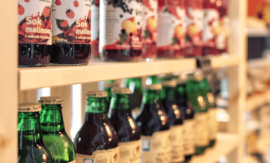Intended learning outcomes: Produce an overview on the subprocesses of a business process in the enterprise, from order acquisition to fulfillment. Describe the interface between subprocesses according to the model “customer-supplier relationship with an internal order”.
Process transitions arise when several people or groups work independently of one another within a business process. In general, for a value-adding process of any complexity, a business process must be divided into a number of subprocesses. Crucial are the states of goods between subprocesses and particularly the event (see above) that detects the state, or momentary standstill. Two subprocesses must be connected by an interface. This guarantees that the they cannot be torn apart in time, but will take place one right after the other.
Figure 4.2.1.1 emphasizes the fact that the customer’s logistics are ongoing throughout this whole period. The customer keeps track of order fulfillment, as the goods ordered are needed for fulfilling the customer’s own tasks (in design and manufacturing) or for use.
Fig. 4.2.1.1 Business process in the enterprise from order acquisition to fulfillment.
How should the business process be organized into subprocesses, as soon as more people are needed for order acquisition and fulfillment than can be incorporated into one single group? Experience has shown that each transition from subprocess to subprocess is critical. This is the reason why the design of the interfaces is so important.
Figure 4.2.1.2 shows a common solution to the problem. This example has been taken from a midsized company in the metals industry. Transitions are defined by the way that an order arises or is formulated between the persons or groups of persons involved.
Fig. 4.2.1.2 Interface between subprocesses: “customer-supplier relationship with an internal order” model and pull logistics.
Design and manufacturing is viewed here as its own business process, as the sales department has issued an internal order to the design/manufacturing departments. Here, sales is the internal customer, and design/ manufacturing the internal supplier. Sales, however, remains responsible to the customer for order fulfillment during the entire design and manufacturing period. Through continuing coordination, or in other words, the exchange of control information, the order is eventually fulfilled. The “customer,” whether internal or external, places an order and “pulls” the logistics in such a way that the logistics produce the goods ordered for delivery. The customer remains an active monitor, at least potentially, throughout the entire delivery lead time.
This results in cascades, that is, a number of process levels in the process model.
Pull logistics is the name for this system: Value-adding takes place only on customer demand or to replace a use of items. Its characteristic is that several parallel order processes arise. This means that several order managing persons concern themselves with the value-adding process simultaneously. With regard to delivery reliability rate, each customer, through coordination with the supplier, “pulls” the order on up through the process levels.
This kind of logistics ensures that nothing is “forgotten.” Parallel order management in multiple levels is in itself, of course, not value-adding. From a lean production perspective in a narrow sense, it may even be wasteful. However, from an agility perspective, this slack is necessary if logistics are to be effective in this model. The interface in the cascade model is formed mainly through the formulation of the order. Customer and supplier must reach an agreement. These negotiations represent slack, and thus unnecessary expenditure, but they do result in an overall effective business process.
Course section 4.2: Subsections and their intended learning outcomes

4.2 Push Logistics and Pull Logistics in the Design of Business Processes
Intended learning outcomes: Differentiate between pull logistics and push logistics. Describe the temporal synchronization between use and manufacturing with inventory control processes.

4.2.1 Pull Logistics
Intended learning outcomes: Produce an overview on the subprocesses of a business process in the enterprise, from order acquisition to fulfillment. Describe the interface between subprocesses according to the model “customer-supplier relationship with an internal order”.

4.2.2 Push Logistics
Intended learning outcomes: Describe the interface between subprocesses according to the model “simple sequence”. Explain the interface between subprocesses according to the model “partner relationship with overlapping subprocesses for handing over the order”.

4.2.3 The Temporal Synchronization between Use and Manufacturing with Inventory Control Processes
Intended learning outcomes: Differentiate between different inventory-control processes for temporal synchronization between use and manufacturing / procurement. Describe the example of pull logistics for order processing with end-product inventory replenishment after consumption.
